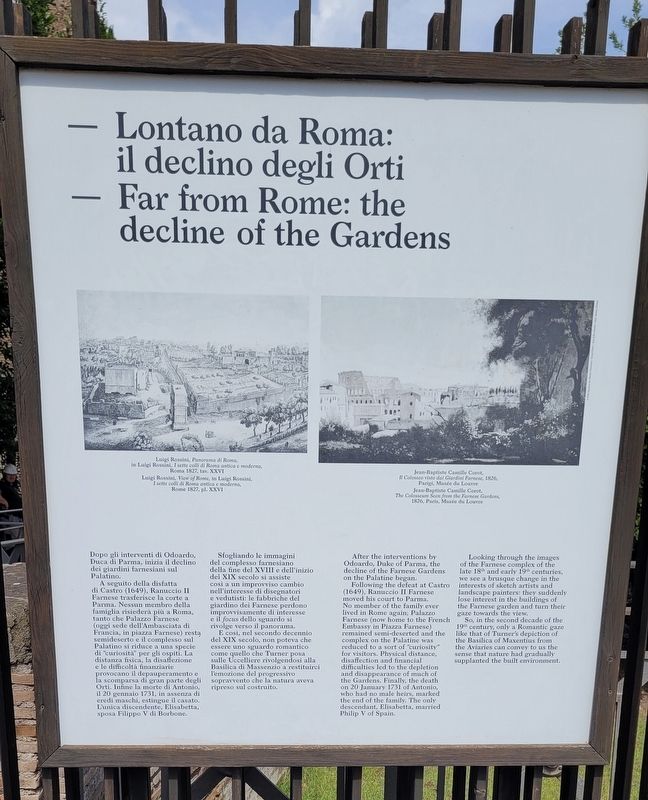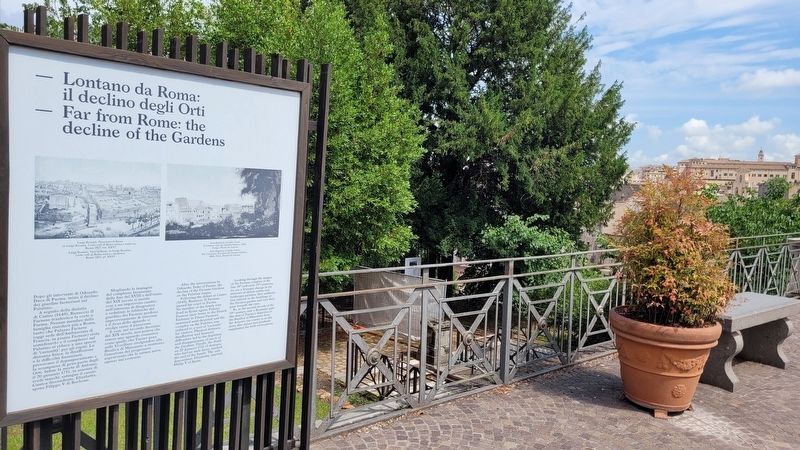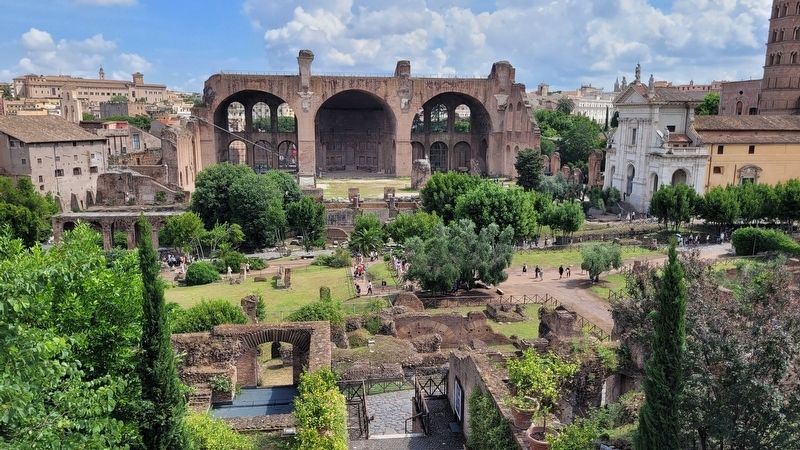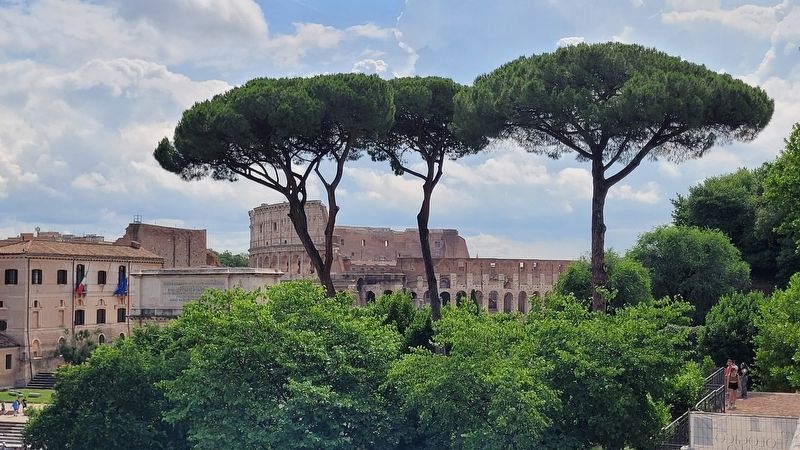Rione X Campitelli in Roma in Città metropolitana di Roma Capitale, Latium, Rome, Italy — Central Italy (Tyrrhenian Coast)
Lontano da Roma: il declino degli Orti / Far from Rome: the decline of the Gardens
Inscription.
A seguito della disfatta di Castro (1649), Ranuccio II Farnese trasferisce la corte a Parma. Nessun membro della famiglia risiederà più a Roma, tanto che Palazzo Farnese (oggi sede dell'Ambasciata di Francia, in piazza Farnese) restą semideserto e il complesso sul Palatino si riduce a una specie di "curiosità" per gli ospiti. La distanza fisica, la disaffezione e le difficoltà finanziarie provocano il depauperamento e la scomparsa di gran parte degli Orti. Infine la morte di Antonio, il 20 gennaio 1731, in assenza di eredi maschi, estingue il casato. L'unica discendente, Elisabetta, sposa Filippo V di Borbone.
Sfogliando le immagini del complesso farnesiano della fine del XVIII e dell'inizio del XIX secolo si assiste così a un improvviso cambio nell'interesse di disegnatori e vedutisti: le fabbriche del giardino dei Farnese perdono improvvisamente di interesse e il focus dello sguardo si rivolge verso il panorama.
E così, nel secondo decennio del XIX secolo, non poteva che essere uno sguardo romantico come quello che Turner posa sulle Uccelliere rivolgendosi alla Basilica di Massenzio a restituirci l'emozione del progressivo sopravvento che la natura aveva ripreso sul costruito.
Didascalie
Luigi Rossini, Panorama di Roma, in Luigi Rossini, I sette colli di Roma antica e moderna, Roma 1827, tav. XXVI
Jean-Baptiste Camille Corot, Il Colosseo visto dai Giardini Farnese, 1826 , Parigi, Musée du Louvre
After the interventions by Odoardo, Duke of Parma, the decline of the Farnese Gardens on the Palatine began.
Following the defeat at Castro (1649), Ranuccio II Farnese moved his court to Parma. No member of the family ever lived in Rome again; Palazzo Farnese (now home to the French Embassy in Piazza Farnese) remained semi-deserted and the complex on the Palatine was reduced to a sort of "curiosity" for visitors. Physical distance, disaffection and financial difficulties led to the depletion and disappearance of much of the Gardens. Finally, the death on 20 January 1731 of Antonio, who had no male heirs, marked the end of the family. The only descendant, Elisabetta, married Philip V of Spain.
Looking through the images of the Farnese complex of the late 18th and early 19th centuries, we see a brusque change in the interests of sketch artists and landscape painters: they suddenly lose interest in the buildings of the Farnese garden and turn their gaze towards the view.
So, in the second decade of the 19th century, only a Romantic gaze like that of Turner's depiction of the Basilica of Maxentius from the Aviaries can convey to us the sense that nature had gradually supplanted the built environment.
Captions
Luigi Rossini, View of Rome, in Luigi Rossini, I sette colli di Roma antica e moderna, Rome 1827, pl. XXVI
Jean-Baptiste Camille Corot, The Colosseum Seen from the Farnese Gardens,1826 , Parigi, Musée du Louvre
Topics. This historical marker is listed in these topic lists: Anthropology & Archaeology • Architecture • Arts, Letters, Music. A significant historical date for this entry is January 20, 1731.
Location. 41° 53.432′ N, 12° 29.236′ E. Marker is in Roma, Lazio (Latium, Rome), in Città metropolitana di Roma Capitale. It is in Rione X Campitelli. Marker is at the intersection of Via Sacra and Via Nova on Via Sacra. The marker is located west of the Arch of Titus in the Roman Forum. Touch for map. Marker is in this post office area: Roma, Lazio 00186, Italy. Touch for directions.
Other nearby markers. At least 8 other markers are within walking distance of this marker. Uccelliere / Aviary (a few steps from this marker); Teatro del Fontanone / Fountain Theater (a few steps from this marker); Il restauro / The conservation project (a few steps from this marker); Giacomo Boni sul Palatino / Giacomo Boni on the Palatine (a few steps from this marker); Le ragioni dell'archeologia / The development of archaeology (within shouting distance of this marker); Le Rose del Viridarium / The Roses of the Viridarium (within shouting distance of this marker); I giardini del XIX secolo / The gardens of the 19th century (within shouting distance of this marker); Con gli occhi di Goethe / With the eyes of Goethe (within shouting distance of this marker). Touch for a list and map of all markers in Roma.
More about this marker. The marker is located in the Parco Archeologico del Colosseo (Roman Forum Archaeological Park) and it does require an entry fee to visit.
Also see . . .
1. Parco Archeologico del Colosseo. Roma Turismo (Submitted on August 5, 2023, by James Hulse of Medina, Texas.)
2. Farnese Gardens. Wikipedia
The Farnese Gardens, or "Gardens of Farnese upon the Palatine", are a garden in Rome, central Italy, created in 1550 on the northern portion of Palatine Hill, by Cardinal Alessandro Farnese. They were the first private botanical gardens in Europe; the first botanical gardens of any kind in Europe were started by Italian universities in the mid-16th century, only a short time before.(Submitted on August 6, 2023, by James Hulse of Medina, Texas.)
Credits. This page was last revised on August 8, 2023. It was originally submitted on August 5, 2023, by James Hulse of Medina, Texas. This page has been viewed 52 times since then and 9 times this year. Photos: 1, 2, 3, 4. submitted on August 6, 2023, by James Hulse of Medina, Texas.



